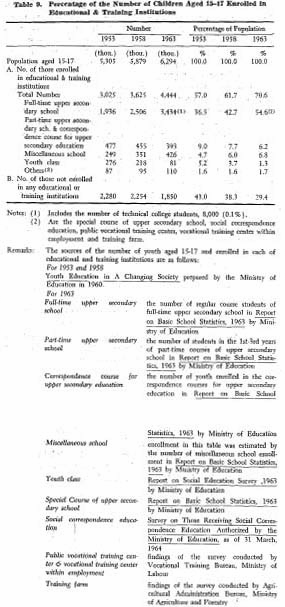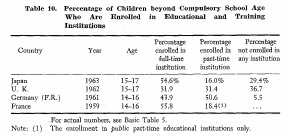| Home > Policy > White Paper, Notice, Announcement > White Paper > EDUCATIONAL STANDARDS IN JAPAN 1965 > CHAPTER1 2 (3) | ||
In addition to the part-time upper secondary school and the correspondence course for upper secondary education, these educational and training institutions for working youth exist in Japan; miscellaneous school, youth class, social correspondence education, public vocational training center, vocational training center within employment and training farm. In 1963, the population of youth aged 15-17 was approximately 6,290,000, of which 54.6 per cent was enrolled in the full-time upper secondary schools, 6.2 per cent in the part-time upper secondary schools and the correspondence course for upper secondary education and 9.8 per cent in miscellaneous schools, youth classes and other educational and training institutions. The number of those who were not enrolled in any educational or training institution was 1,850,000 (29.4%).
Comparison of the numbers and percentages of youth receiving education or training at such institutions in 1953, 1958 and 1963, shows that the greatest was in the enrollment in full-time upper secondary schools. Part-time upper secondary school enrollment decreased, mainly in such schools conducted during the daytime in rural areas. The number of miscellaneous school students in urban areas increased considerably in proportion to the larger inflow of youth into such areas. Increases in the number of students are outstanding in the courses for commerce, abacus, bookkeeping and the new types of practical skill, such as typewriting. The number of youth class students has recently shown a declining tendency as the agricultural population decreases.
The fact that there were still in 1963 about 1,850,000 youths who were not enrolled in any educational or training institution represents a great social and individual loss and points up the immediate need for renovating the nation's upper secondary education to meet the requirements of this large segment of the nation's population.
The percentage of the compulsory school graduates enrolled in part-time educational or training institutions in Japan is higher than in the United Kingdom, West Germany and France. The percentage of compulsory school graduates not enrolled in any institutions is higher in the United Kingdom than in Japan. The low percentage in West Germany and France is due to the fact that in both countries, compulsory school graduates not entering any full-time school of higher level, are required to attend institutions of part-time education until they reach 18 years of age.


| Back to Top | MEXT HOME |